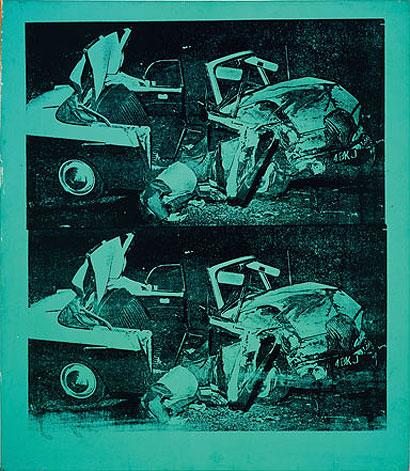|
Damien Hirst, Suicide Bomber (Aftermath), 2004-2005 (image: © Damien Hirst, DACS 2010/Rob McKeever) |
||
|
The Gagosian has gathered the art world’s great and good in tribute to the later author JG Ballard. William Wiles finds few surprises but much enjoyable viscera A name like Crash writes a pretty big cheque for a show dedicated to the influence of the British author JG Ballard, who died last year. Before writing the book of the same name, Ballard himself presented a gallery show called Crashed Cars in 1970. Intending to reveal the erotic qualities of the auto-smash, the writer stocked London’s New Arts Laboratory with three wrecked cars, and had a topless model pose with them. Ballard triangulated sex, violence and hyper-modern culture together like very few other authors, and pursued that same vision for four decades. As a result of Ballard’s determined pursuit of consistent themes, “Ballardian” qualities are now pretty well defined, and the Gagosian’s show consequently contains much that is provocative but little that is very surprising. Arriving at the King’s Cross gallery, one is confronted by the swollen wheels of a Boeing 747’s landing gear – Adam McEwen’s Honda Teen Facial, 2010 – and the hairgel lines of Elvis, a car body presented as sculpture by Richard Prince. The rest of the show is split three ways. There are the artists that inspired Ballard – surrealists such as Dalí, de Chirico and (a favourite of his) Paul Delvaux; art that sprang from the same experimental milieu as Ballard’s boldest writing, including Eduardo Paolozzi (who became a good friend of the author); and newer names who have drawn inspiration from Ballard’s writing, such as Roger Hiorns and Tacita Dean. That sampling doesn’t do justice to the sheer number of star names crammed into the show. The cumulative effect is quite powerful. Christopher Wool’s chaotic crime scene photographs, an Andy Warhol car-crash montage, Helmut Newton’s beauties in neck braces, the blood-splattered pulp deviance of Richard Prince’s wayward nurse, similarly bloody religious and technological epiphanies from Damien Hirst, automotive sexuality from Richard Hamilton, body-horror from Cindy Sherman and Jenny Saville. Inevitably, and unsurprisingly, it brings to mind The Atrocity Exhibition, paintings on the theme of cataclysm collected for pathological purposes in Ballard’s spectacular experimental novel of 1969. It’s a reminder that the shock tactics associated with contemporary art of the 1990s and 2000s are in fact nothing very new. Crash could have been improved by pruning back that crowded marquee. Some of the work is of dubious relevance, and could have been left out without doing harm to the show. Basquiat, to take a prominent example, seems like an odd choice. Other works are not displayed well. Douglas Gordon’s scarred and mirrored “Self Portraits” with James Dean and Jayne Mansfield are almost hidden behind a Mike Nelson installation. Paolozzi is treated particularly badly. His brilliant, loving, acid-drop pop-culture collages are stuck in part of the Gagosian’s foyer that is little more than a connecting corridor. For an artist with an intimate connection with Ballard, via Ambit magazine (a poetry quarterly founded in 1959), and works that are easily among the best in the show, this is most unfair. Ballard himself is under-represented: there’s the 1958 Project for a New Novel, a seminal experiment with free-association and found texts, but none of his “Advertiser’s Announcements” for Ambit, a bizarre omission. As Ballard-themed entertainment, Gagosian’s Crash succeeds very well – it’s a fine collection of art that is well worth seeing. As homage, it’s less successful. Lacking clear focus, the overall effect is to strip Ballard’s work of its criticism and reduce it to a collection of all-purpose imagery – car crashes, high-rises, body-horror eroticism. That makes for an interesting theme, but a diffuse tribute. And some of this imagery is now worryingly banal – a Ballardian fact in itself. Crash: Homage to JG Ballard is at Gagosian’s Britannia Street gallery, London, until 1 April
Andy Warhol, Green Disaster (Green Disaster Twice), 1963 (image: © 2010 The Andy Warhol Foundation/Rob McKeever) |
Words William Wiles |
|
|
||



















